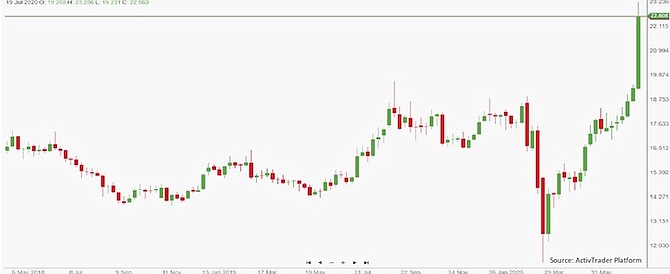ActivTrades Weekly
By Ricardo Evangelista
www.activtrades.bs
Despite the mayhem caused by the coronavirus pandemic and rising Sino-American tensions, an old favourite has managed to keep its sparkle. I'm talking about gold, of course. The precious metal price rose almost 20 percent since early April and is quickly approaching the 2011 all-time high, of $1,917 per ounce. The most remarkable aspect of gold’s latest rally is the fact that it’s occurring during a bull market, when stocks are in an upwards trend, which is unusual. It could be a sign that many investors are hedging their bets, despite the apparent optimism reflected by the gains in the main stock indices.
Gold is traditionally seen as a safe haven, sought after during periods of uncertainty and crisis. Because of its intrinsic value, it remains a viable investment when inflation climbs, and currencies devalue. At such times, the price of the precious metal tends to go up, while risk-related financial assets, such as stocks, normally decline. Interestingly, the rise of gold usually occurs only after the initial shock of a stock market crash has passed; frequently market operators will react to the early downfall by selling any bullion they may be holding, in order to withstand margin calls and cover losses incurred elsewhere.
But after the initial shock, gold invariably rises. The financial crisis of the late 2000s provides a good illustration for these mechanics: in late 2007, as the financial markets, as well as the real economy, entered a period of decline, in the immediate aftermath of the subprime mortgage collapse, the price of the precious metal also dropped, from nearly $1000 to around $700 per ounce. However, half-way through 2008, as stock markets continued to deteriorate and investors braced for a long period of central bank stimulus and feeble economic growth, the value of gold began to increase, until mid-2011, when it reached its all-time high of more than $1900.
But gold isn’t the only metal currently shining. The performance of silver is even more impressive; last week, for the first time since 2013, its price reached $23 per ounce, an increase of more than 100 percent from a bottom of $11.28 recorded in March 2020. Many analysts estimate its value could continue to rise and approach the all-time maximum of $49.51, reached in 2011. The dynamics behind silver pricing are similar to the ones highlighted in relation to gold, with an additional dimension provided by its industrial commodity status.
It is estimated that 50 percent of the current global demand for silver originates from the industrial sector. Among countless other manufacturing uses, the precious metal is a vital component of photovoltaic cells used in energy generating solar panels. As governments around the world seek to reboot their pandemic-hit economies, and funding for new renewable energy programmes is announced, demand for the required raw materials increases, pushing prices up.
As currency, instruments for financial speculation or industrial commodities, gold and silver have always played an important role in our way of living, and that isn’t likely to change anytime soon.






Comments
Use the comment form below to begin a discussion about this content.
Sign in to comment
Or login with:
OpenID